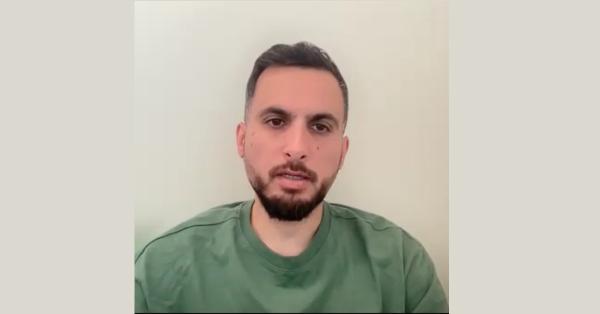The following is from a rush transcript from a longer interview Alan Goodman did with Dr. Mohamad Abdelfattah, an intensive care unit (ICU) physician from Southern California and an organizer with Orange County for Justice in Palestine. Dr. Abdelfattah describes the experience of serving at the European Gaza Hospital (EGH) in Gaza for three weeks in May. The entire interview will be aired on the upcoming episode of The RNL—Revolution, Nothing Less!—Show on YouTube.

Dr. Mohamad Abdelfattah
Alan Goodman: So now let’s move to the kind of experience you had. What is your specialty as a physician and what kind of work were you doing as a doctor in the hospital?
Dr. Mohamad Abdelfattah: Sure, so back here in the states I’m an ICU physician, and my role on this mission was to help out in the intensive care unit at EGH and then I also spent time in the emergency room. And so my first day there I wanted to go check out the ER, see what capabilities they had. And it was immediately just, I was blown back by the fact that how many people are in the ER, just overrun, patients on the floor, all patients in every bed. And so there’s a resuscitation room where the critical patients go and I walked into that room and just immediately noticed kids, it was about a year and a half year old kid, a boy, he was holding his arm up and just screaming, crying uncontrollably in pain. And I looked at his arm and you just see his whole forearm, the the skin is peeling off, he’s got a severe burn and he’s just screaming asking for his dad. And that was difficult for me you know, having a kid, a boy around his age. And literally right adjacent to him was another baby, about a two month old sitting in her mom’s arms just crying uncontrollably. And her foot was—there was a large laceration, a large gash in her foot and you can see the muscle layers of her foot, it was a very deep wound. This was from shrapnel and this was like a probably a four month old girl crying. Like she had curls in her hair and it was just really a devastating scene to immediately—this is the first thing I saw was kids you know, being the victims of this war.
And that was the continued trend to be honest with you. And you know that first day it was overwhelming for me and I had to actually leave, I was like you know, I’m sorry I can’t help here. There was another ER doctor that was with our group, he was already there and so he was taking care of the patients, and I told him look, I’m sorry, I have to leave.
So I went to the ICU, and in the ICU just another scene that I’m not used to seeing, just the ICU monitor is consistently going off, the alarms beeping. Now usually in a traditional ICU when an alarm is going off on a monitor it’s an emergency situation, it’s a disaster, people are responding. But throughout the ICU the alarms are just continuously going off and that’s because the monitors, the sensors themselves, are defective so they’re not accurately picking up the right signals. So they’re constantly alarming and the staff, they’re not taking those alarms seriously because they know they’re defective. So as soon as you walk into the ICU that’s one thing you hear are the alarming monitors. You know, just looking at the ICU what strikes, what was very obvious was the amount of children in the ICU. So I’m an adult ICU physician, I don’t treat kids. But in the EGH intensive care unit there’s an adult bed and right adjacent to him is a child. And so majority of the victims in the ICU of the sick were kids of all ages, four months old up to 10-, 11-, 12-year-olds on ventilators with severe burns, horrific explosive injuries where they have shrapnel all over their bodies, amputated limbs because of the severity of their injuries. The burn patients, you know, when you have burn wounds you have to wrap these wounds in bandages and change them very frequently.
However, because of the lack of staff and resources, not being able to change these dressings daily, they’re becoming infected and so a lot of the dressings of wounds are weeping, are weeping liquids, blood and yellow liquids weeping from these dressings. And what you notice is flies flying around the ICU, there are flies landing on these wounds and then traveling to the next-door patients. And so there’s no infection control in the ICU. Bacteria, very aggressive resistant bacteria are spreading throughout the ICU. They don’t have hand soap, the staff, the doctors, the nurses don’t have hand soap to wash their hands and so there’s no way to prevent this sort of bacteria from spreading. All of the ventilators what we noticed while we were there are contaminated with very resistant bacteria. So when someone needs a ventilator, what you’ll notice after a few days is that you’re dealing with a really aggressive pneumonia because the ventilators are contaminated with this bacteria. So it’s horrific scene to be honest….